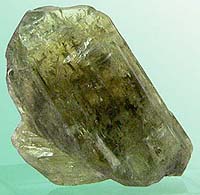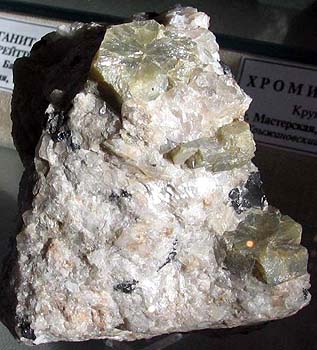Spinel (oxides): Chrysoberyl
 Diagnostic Card.
Diagnostic Card.
In the photo: a variety of chrysoberyl - alexandrite. Below: chrysoberyl crystal of Colatina (Brazil).
Al 2 Be O 4
Crystal system orthorhombic
8.5 Hardness
Specific gravity 3.7
Cleavage indistinct along the base
fracture conchoidal
Colour colorless, differently colored
Color white powder
Shine from glass to polualmaznogo

Chrysoberyl is known since ancient times, it got its name from the Greek chrisos - gold. Currently especially appreciated its varieties and alexandrite tsimofan - "cat's eye". The most known deposits actually chrysoberyl (3,9,10) - placers Brazil (Minas Novas, Minas Gerais pcs.) And Sri Lanka; In addition, it is found in Upper Burma, on the island of Madagascar, in Zimbabwe and in the CIS (in the Urals).
Similar to the chrysoberyl minerals such as green andalusite, Brasiliano, golden beryl, giddenit, peridot, green sapphire, Sinhalese, scapolite, spinel, topaz, tourmaline, zircon. Alexandrite (5-8) was named in honor of the Russian Emperor Alexander II. This is one of the rarest and most valuable gemstones in the world. In daylight, it's green and in the evening and by artificial light - raspberry. Changing the color becomes distinct with increasing thickness of the stone. Painting due admixture of chromium.

Especially rare alexandrite "cat's eye". In the treatment of alexandrite requires caution: it is brittle, can easily crack when squeezed. With increasing temperature, the stone changes color, and it is unstable to alkali.
The only known indigenous alexandrite deposit is located in the Urals. Currently, the most important are Sri Lanka and Zimbabwe placers. In addition, deposits of alexandrite known in Burma, Brazil, Madagascar, and of Tasmania, as well as in the United States. The largest alexandrite weighing 1876 carats was found in Sri Lanka, the largest of the faceted alexandrite has a weight 66 carat and is owned by the Smithsonian Institution in Washington.
In appearance the closest to alexandrite synthetic "alexandrite" corundum colored by vanadium: in daylight it is pale green in color, while the electric becomes intense strawberry pink. Simulates alexandrite and synthetic spinel. They are made as doublets with a clear change of colors: the upper part of them is made of red pomegranate, and the bottom - green glass (found in antique jewelry).
Chrysoberyl - cat's eye, it is also called tsimofanom - from the Greek jackpot - wave and phan - appear. This is a very attractive variety of chrysoberyl. Subparallel and randomly arranged tubules filled with air, looks like a thin silver rays; in stone, polished cabochon, an effect of the movable light wave - running through light strips. The name "cat's eye" stone was precisely because of this effect. It should be noted that the "cat's eye" is called chrysoberyl-tsimofan. all other gems with the effect of "cat's eye" in need of clarification. Deposits "cat's eye" known in Sri Lanka, Brazil and China. It can only be confused with quartz cat's eye.
 Chrysoberyl presented with beautiful crystals, often imperfect, prismatic and tapered shape. They are often combined as a counterpart in the form of Latin "V". Images and ring-shaped counterparts of the three individuals, sometimes in the form of stars. The appearance of hexagonal crystals. On their faces is often a parallel hatching.
Chrysoberyl presented with beautiful crystals, often imperfect, prismatic and tapered shape. They are often combined as a counterpart in the form of Latin "V". Images and ring-shaped counterparts of the three individuals, sometimes in the form of stars. The appearance of hexagonal crystals. On their faces is often a parallel hatching.
Chemical composition, the content (in%): BeO, 19.8; Al2O3 - 80,2; observed impurity iron, chromium. Crystal system - rhomboid, rhombus-dipiramidalny kind of symmetry. Cleavage - imperfect at (110). It occurs in the form of tolstotablitchatyh, less short- and long-prismatic crystals pseudohexagonal with the main forms (001) (110) (010) (111) (121); characterized by doubles and tees at (130) with a sharp radial shading.
Painting chrysoberyl diverse (allohromaticheskaya). It is defined by small impurities of iron and chrome yellow in changeable colored varieties - Alexander. Alexandrite - green in sunlight and red in incandescent light. Inside chrysoberyl crystals present various inclusions. Due to this there is the phenomenon of iridescent color; This kind is called tsimofan.
Diagnostic features.
This mineral is usually determined accurately the nature of twinning.
Origin.
Chrysoberyl is formed in pegmatites and in metamorphic rocks (mica schist). His main field - secondary type, mainly alluvial gravels where chrysoberyl is present in the form of rounded pebbles.
 Place of Birth.
Place of Birth.
Excellent tsimofana samples found in secondary deposits such as in Brazil and Sri Lanka. Ural deposits developed.
The use in jewelry.
Transparent crystals of chrysoberyl and all its variants are used in jewelry. Cut chrysoberyl is generally something like a tent (the outer part of the precious stone), very large and wide, consisting of a plurality of facets, faces close to a rectangular shape. It is very expensive gemstone.
Tsimofan (also incorrectly referred to as "eye oriental cats") - this is the most used variety of chrysoberyl. The name comes from the Greek word meaning "wave-like", which reflects the unique and eye-pleasing effect iridescent color. It is due to the presence of microscopic tubules inside the crystal, which creates the interference of light rays.
Color green with a yellowish sheen, bluish, purple and slightly pinkish. Tsimofan comes mainly from Sri Lanka and Brazil. The best form of cut, giving the most beautiful iridescence effect, - a curve or surface cabochon.


Chrysoberyl. Tees in feldspar pegmatite with schorl. USA. Chrysoberyl. Tee splice. Emerald Mines, Wed. Ural, Russia. Photo: © AA Evseev.
- Gatchell - "New Almadén snag" - arsenide and antimony sulfide (modern sulphosalts)
- Antimony - toxic metal (semi-metal) are widely used in industry, medicine and engineering
- Zirconium - a rare and non- metal and dangerous jewel in the oxide and salts
- Gold - yellow dangerous and toxic metal -date and accurate digital cable technology
- Sulphur - a golden-yellow toxic substance and a sign of volcanic activity
- Cadmium - a toxic uncirculated unknown wide range of people silvery metal
- Lead - a poisonous gray simulator silver metal and toxic metal snag
- Arsenic - poison classic medieval and modern poisoners and medicine in medicine
Toxic and hazardous radioactive rocks and minerals
** - Poisonous stones and minerals (obligatory check in chemical laboratory + clear indication of toxicity)
** - Radioactive rocks and minerals (obligatory check on a regular dosimeter + ban on the open sale of radioactivity in the event of more than 24 mR / hour + additional measures to protect the population)
Catalog minerals and gems in groups of the world
** - Poisonous stones and minerals
** - Radioactive rocks and minerals


Comments
Commenting, keep in mind that the content and the tone of your messages can hurt the feelings of real people, show respect and tolerance to his interlocutors, even if you do not share their opinion, your behavior in terms of freedom of speech and anonymity offered by the Internet, is changing not only virtual, but real world. All comments are hidden from the index, spam control.